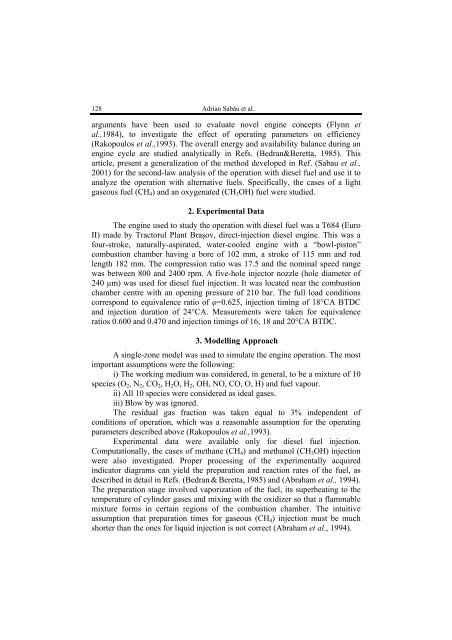buletinul institutului politehnic din iaşi - Universitatea Tehnică ...
buletinul institutului politehnic din iaşi - Universitatea Tehnică ...
buletinul institutului politehnic din iaşi - Universitatea Tehnică ...
Create successful ePaper yourself
Turn your PDF publications into a flip-book with our unique Google optimized e-Paper software.
128 Adrian Sabău et al.<br />
arguments have been used to evaluate novel engine concepts (Flynn et<br />
al.,1984), to investigate the effect of operating parameters on efficiency<br />
(Rakopoulos et al.,1993). The overall energy and availability balance during an<br />
engine cycle are studied analytically in Refs. (Bedran&Beretta, 1985). This<br />
article, present a generalization of the method developed in Ref. (Sabau et al.,<br />
2001) for the second-law analysis of the operation with diesel fuel and use it to<br />
analyze the operation with alternative fuels. Specifically, the cases of a light<br />
gaseous fuel (CH4) and an oxygenated (CH3OH) fuel were studied.<br />
2. Experimental Data<br />
The engine used to study the operation with diesel fuel was a T684 (Euro<br />
II) made by Tractorul Plant Braşov, direct-injection diesel engine. This was a<br />
four-stroke, naturally-aspirated, water-cooled engine with a “bowl-piston”<br />
combustion chamber having a bore of 102 mm, a stroke of 115 mm and rod<br />
length 182 mm. The compression ratio was 17.5 and the nominal speed range<br />
was between 800 and 2400 rpm. A five-hole injector nozzle (hole diameter of<br />
240 µm) was used for diesel fuel injection. It was located near the combustion<br />
chamber centre with an opening pressure of 210 bar. The full load conditions<br />
correspond to equivalence ratio of φ=0.625, injection timing of 18°CA BTDC<br />
and injection duration of 24°CA. Measurements were taken for equivalence<br />
ratios 0.600 and 0.470 and injection timings of 16, 18 and 20°CA BTDC.<br />
3. Modelling Approach<br />
A single-zone model was used to simulate the engine operation. The most<br />
important assumptions were the following:<br />
i) The working medium was considered, in general, to be a mixture of 10<br />
species (O2, N2, CO2, H2O, H2, OH, NO, CO, O, H) and fuel vapour.<br />
ii) All 10 species were considered as ideal gases.<br />
iii) Blow by was ignored.<br />
The residual gas fraction was taken equal to 3% independent of<br />
conditions of operation, which was a reasonable assumption for the operating<br />
parameters described above (Rakopoulos et al.,1993).<br />
Experimental data were available only for diesel fuel injection.<br />
Computationally, the cases of methane (CH4) and methanol (CH3OH) injection<br />
were also investigated. Proper processing of the experimentally acquired<br />
indicator diagrams can yield the preparation and reaction rates of the fuel, as<br />
described in detail in Refs. (Bedran & Beretta, 1985) and (Abraham et al., 1994).<br />
The preparation stage involved vaporization of the fuel, its superheating to the<br />
temperature of cylinder gases and mixing with the oxidizer so that a flammable<br />
mixture forms in certain regions of the combustion chamber. The intuitive<br />
assumption that preparation times for gaseous (CH4) injection must be much<br />
shorter than the ones for liquid injection is not correct (Abraham et al., 1994).

















